Special | Could Soil Deficient in Iron Be Fuelling Anaemia in Marathwada?
This is part two of a series investigating the fallout of Maharashtra’s sugar boom. Read part one here and part three, here.
Twenty two-year-old Jyoti Gharat had to take iron-folic acid tablets every day after she found out she was pregnant late last year. When she didn’t take her medication, she would often have headaches. Gharat was diagnosed with anaemia five months into her pregnancy. She constantly worried that her condition might affect her unborn child. “I had weakness in my hands and legs. The doctor asked me to increase my red blood cell count,” said Gharat, a homemaker who moved to Beed city along with her husband as soon as they got married.
The first thing Gharat’s doctor in Beed asked her was what she was eating. He gave her a list of things to add to her diet. The problem was that she had already been eating everything her doctor had suggested.

Left to right: Jyoti Gharat with her son at her home during her pregnancy; Jyoti shows the tablets she had to consume every day
Like Gharat, 22-year-old Dipali Kadam, also a homemaker, visited multiple hospitals in Maharashtra’s Beed, including private ones when she fell sick. After taking a number of tests to identify other underlying issues, her blood reports also showed low haemoglobin. “I felt dizzy. My legs hurt. When my BP was low, I felt nauseous,” said Kadam, who was prescribed iron supplements as well.
Several women The Wire spoke to in November last year, between the ages 18 and 30, in drought-prone Beed and Dharashiv districts of Maharashtra, were either undergoing treatment for anaemia or had just recovered. The government’s National Family Health Survey data validates this finding – cases of anaemia have gone up in all districts of Maharashtra’s driest region, Marathwada, between 2015 and 2021.
In part two of a six-month investigation by The Wire into Maharashtra’s sugar boom exploring the wide-ranging consequences of defying nature to grow water-intensive cash crops, we seek to unravel a paradox: as the state profits from sugar, many local women are becoming sicker.
The food on our plate: How nutritious is it?
The science is fairly straightforward. Soil that is leached of its nutrients could impact the meals on our plates. While monocropping depletes iron and other nutrients in the soil as reported in the first part of our series, residents who eat locally grown crops could be suffering the consequences.
The National Family Health Survey data underscores the problem – Beed and Latur districts have seen the highest increase in anaemia levels among women in Marathwada. Both districts are top sugarcane producers in the region. Beed also has deficient iron in the soil. Cases of anaemia in Parbhani, Jalna and Nanded districts in Marathwada are higher than Maharashtra’s average.
These women were referred to us by the district health office that tracks their well-being through community health workers in the region. Most of the women monitored by the health workers were homemakers as they were unable to cover women who migrate to work in sugarcane fields.
Scientific research explains how poor soil health could translate into less nutritious food. A study published in Scientific Reports by US researchers in 2023 helps connect the dots by correlating soil iron availability with haemoglobin levels in women. The paper links iron deficiency in soil with the amount of iron-rich food we eat, but also acknowledges that multiple factors contribute to anaemia. This is significant because globally, India has one of the highest prevalence of anaemia among women of all ages, according to the WHO.
The paper stops short of establishing a direct causal impact between the soil iron and anaemia levels in women because of other limitations such as income levels of households, lack of granular data at the district level, and lack of data on the uptake of iron into the crop.
“We know at the district level, what the average levels of soil, iron, and other nutrients are. But within a district, the individuals that we observe in the NFHS data, we don't know where they are exactly located and what is the soil quality in their vicinity directly,” explains one of the authors of the study, Hemant Pullabhotla, a senior lecturer with the department of economics at Deakin University in Australia. “It’s possible that places that have poor soil quality may also suffer from other disadvantages. The quality of soil may have eroded due to poor land management practises or they may have less access to more iron-fortifying food or higher iron-rich foods in general in dietary patterns.”
We had to rely on anecdotal reports from the women we spoke to in Marathwada about their dietary patterns, and we could not establish a clear connection regarding where their food was sourced from or whether their doctors’ advice was ineffective.
The Deputy Director of Agricultural Engineering department at the Maharashtra Institute of Technology, Deepak Bornare, also points at several variables including the source and non-availability of the food for lack of consumption. “We don’t know which location they have consumed the food from. Food rich in nutrients may not be available locally because of the larger market pattern,” says Bornare.
Anaemia levels among women: What data tells us
While there are several limitations, our anecdotal reporting showed that high anaemia levels was a recurring problem among women we spoke to in Beed and Dharashiv. Jyoti Gharat said she was anaemic the first time she got pregnant as well and she was used to taking iron-folic tablets. “I had 6 points (haemoglobin) then, it increased to 10 because of medicines,” said Jyoti whose doctor told her what to eat but did not explain whether the food she was already eating was a problem.
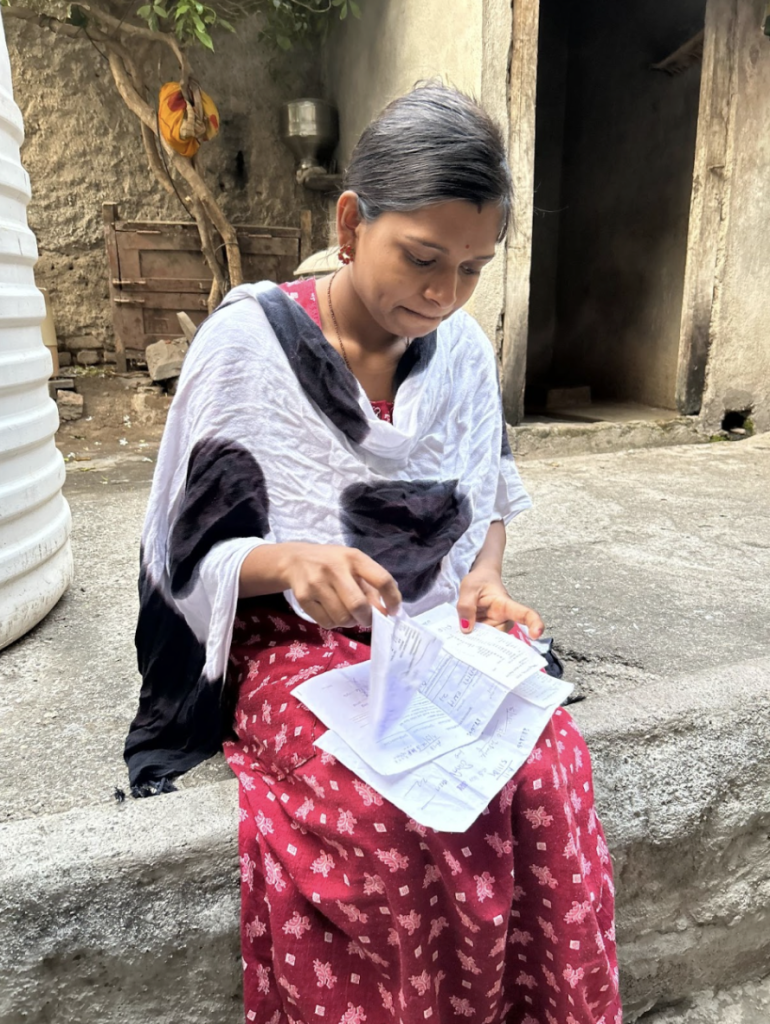
Jyoti recounts her haemoglobin levels during her first pregnancy. Photo: Amitha Balachandra.
Among the other women we spoke to at the city hospital in Beed, who didn’t want to speak on record, there were those who had recovered from anaemia faster because they could afford to buy medicines. Farmer Chhagan Andhale in Beed, who owns a car and has over 15-acre land, says the women in his family take tablets for B12 deficiency.
Dr Vijay Ramachandra Gholve, a gynecologist in Beed, who sees a higher prevalence of such cases in women and children points at inadequate nutrition as the biggest cause. “They are mostly neglecting their health – they are not getting nutritious food,” says Dr Gholve.
Accredited Social Health Workers (also known as ASHA workers) often bridge the gap between patients and primary healthcare centres by conducting door-to-door health surveys. They are the point of contact between patients and the hospitals. “Sometimes when they come to the hospital, they don't eat. We advise them not to do that. We tell them to eat at least some breakfast,” says Alka Magar, an ASHA worker in Dharashiv.
While not eating iron-rich food could lead to anaemia, the National Institute of Nutrition conducted a study last year which said our food’s nutritional value has declined over the last 30 years. When asked for a comment, the National Institute of Nutrition said they “didn’t have data on the nutritional level change over time”. In 2021, a book called Frontiers in Plant-Soil Interaction, written by a group of researchers, linked iron deficiency in soil to poor iron concentrations in food grains, in turn potentially contributing to iron deficiency in human beings.
“In monocropping, nutrients are taken up or absorbed from a particular layer of the soil or particular zone of the rhizosphere. This means if you continuously grow only one crop, the uptake will be continuous from that zone, that is why nutrient deficiency is more in the monocropping system,” says Harihar Kausadikar, professor of soil science at Vasantrao Naik Marathwada Krishi Vidyapeeth in Parbhani.
Women growing sugar suffer health consequences
While we were only referred to residents of these districts by the health officials and community health workers, we also spoke to women who migrate to work in sugarcane fields. Health consequences as a result of this work are massive, whether they are travelling long distances or staying and cutting locally and cultivating their own food as well.
These women not only cook and look after the nutritional needs of their families but also work in the fields without a break. This causes a number of complications – anaemia being one of them. We had to rely on information by non-profits and anecdotal reporting on migrant workers due to lack of granular data at the district health office.
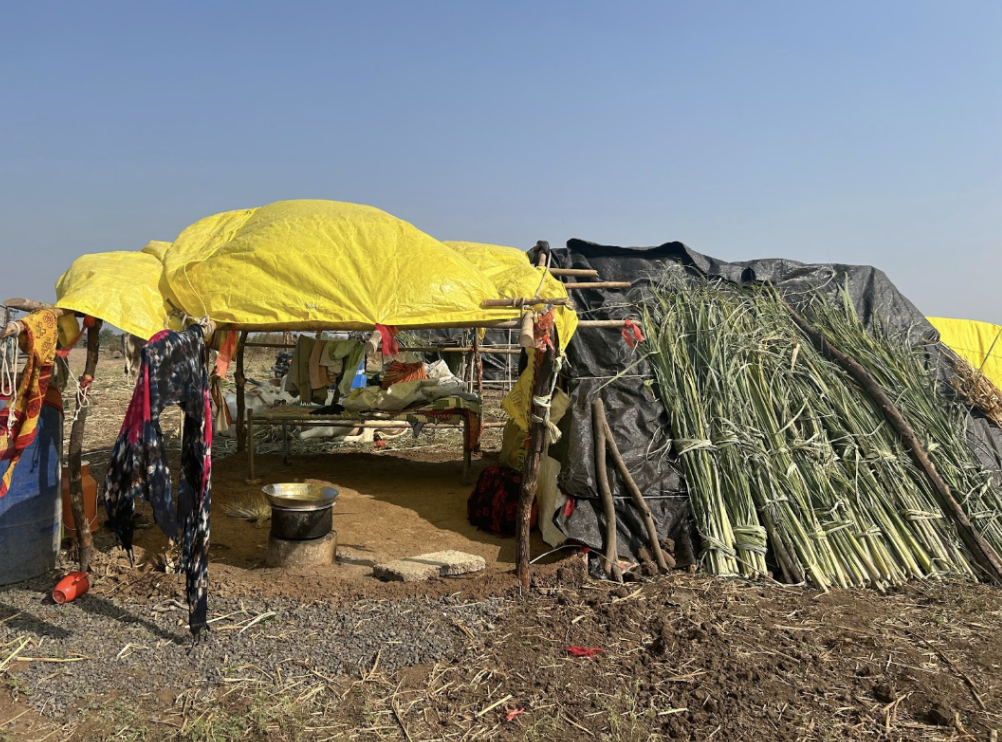
Makeshift tents where migrant workers live. Photo: Amitha Balachandra.
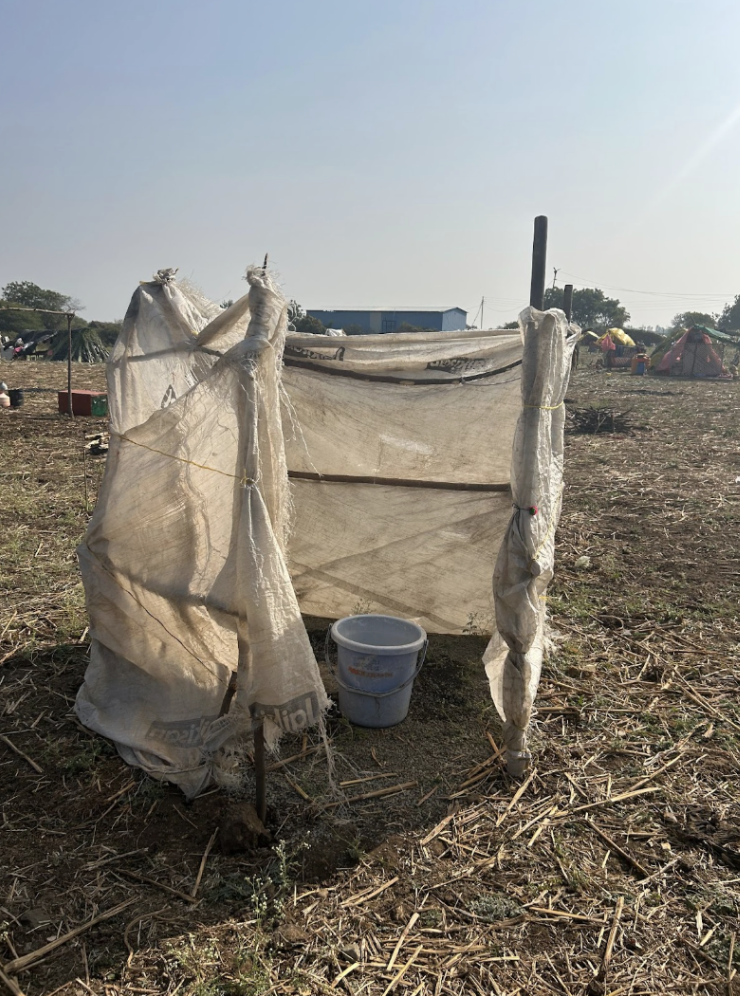
Makeshift bathrooms workers use. Photo: Amitha Balachandra.
Mahila Kisan Adhikar Manch (MAKAAM), a forum for women farmers’ rights, conducted a study right after COVID, when the migrations had begun, to assess the health issues women were facing. “We did see the haemoglobin reports of several of the sugarcane workers, which were very, very concerning. So I think clearly there is an issue there, and that leads to multiple other health problems,” says Seema Kulkarni, senior fellow at SOPPECOM (Society for Promoting Participative Ecosystem Management) and national facilitation team member at MAKAAM. The network works with migrant workers to empower women and ensure their human and health rights are not violated.
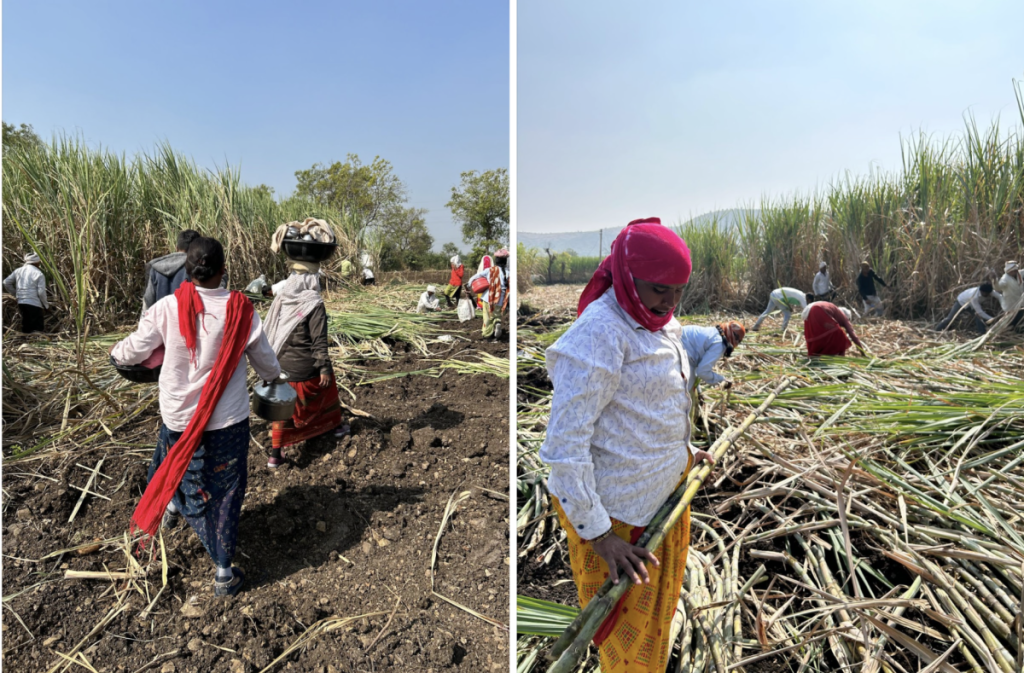
Left, migrant workers head to cut cane. Right, women dressed in flannel jackets and headscarves cutting cane. Photos: Amitha Balachandra.
These migrant workers are usually under the care of a contractor (also known as mukadam – a middleman between sugarcane farmers and factories). For months together, they live out of makeshift tents in poor conditions, earning just enough to repay their debt.
In Beed however, we found a potential change in migration patterns because of the increase in sugarcane production from 2012 to 2022. Many women who were engaged in cane cutting said they were residents of Beed and have had to migrate fewer times over the years.
Small farmer and cane cutter Sindhubhai Ghule is one of them. She decided to grow cotton in 10 guntha (0.25 acre) and sugarcane in 30 guntha (0.74 acre) of her farmland last year to repay her loan. She has been travelling to neighbouring Karnataka for 25 years to cut cane, but has no savings left. She took about 1.5 lakh loan from moneylenders and says growing sugarcane, even for a short period, is the only way to repay some of her debt. The families, residents of Beed, cutting cane for her, have not had to migrate far away as the sugarcane fields in Beed are growing.
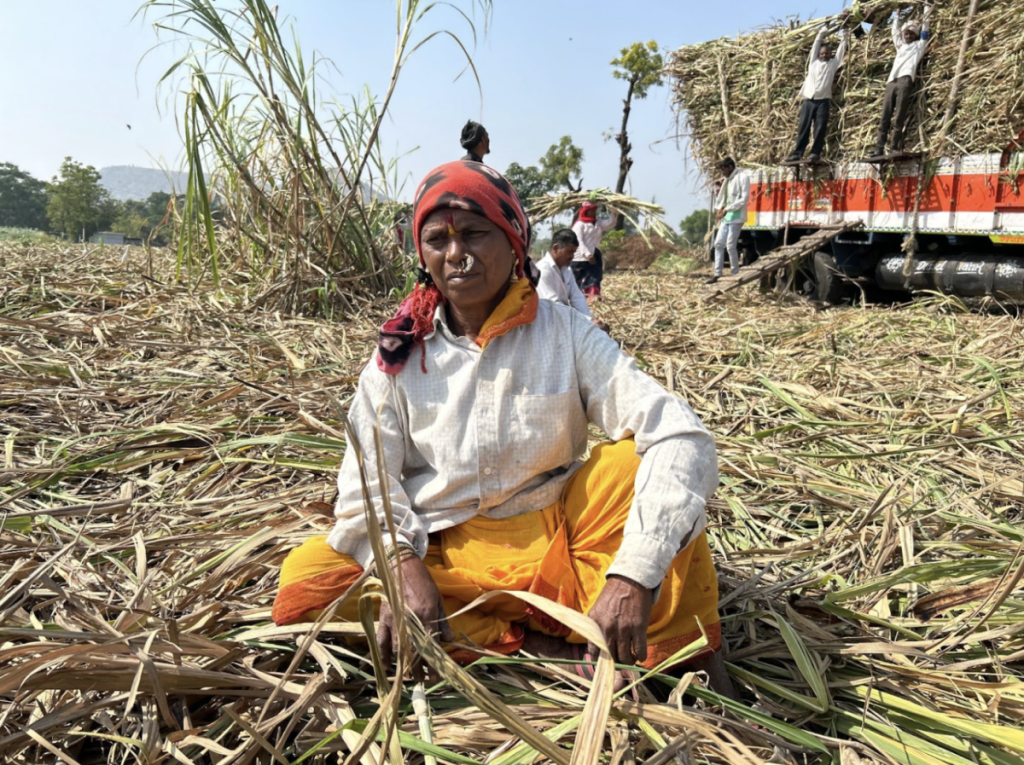
Small farmer Sindhubhai Ghule grew sugarcane last year to repay her loan. Photo: Amitha Balachandra.
“The pattern earlier used to be that, you move out of, let's say, Beed or Parbhani or Jalna, some of the major districts into either Western Maharashtra or Karnataka and you stay there for that final four to six months. But now what we are seeing is that people may come back from there and then in Beed itself, there is a crop to harvest,” says Kulkarni.
The women, however, continue to suffer health consequences.
Independent study finds a link between soil and anaemia levels among farmer households
Certain networks are experimenting with empowering women to grow their own food and eat better. MAKAAM runs a programme in six districts of the state encouraging women to grow mixed crops without using chemicals.
Watershed Organisation Trust (WOTR) conducted a project called the ProSoil project (supported by the German Society for International Cooperation) in 21 villages of Ahilyanagar, Dhule and Jalna districts post COVID to promote better soil health and nutrition. As part of the nutrition component, 25 farmer households each were selected across six villages to test the correlation between anaemia levels and the food they ate. After an initial orientation, farmers began growing multilayer farms with a variety of organic vegetables, free of chemicals, on part of their farm, and grew cash crops on the rest.
“We planned their dietary balance. What should they eat within a week, how many times should they eat eggs, etc. We monitored them over a period of three years,” says Nitin Kumbhar, senior researcher at Watershed Organisation Trust.
The family members' blood was checked for haemoglobin levels before the experiment and after. There was a noticeable positive change in the haemoglobin levels, according to the organisation.
Farmer Kailas Teple’s family found that, after growing and consuming vegetables from their backyard over a period of three years, their haemoglobin levels did improve. Kailas Teple could see a considerable difference in his soil quality after he used organic manure.
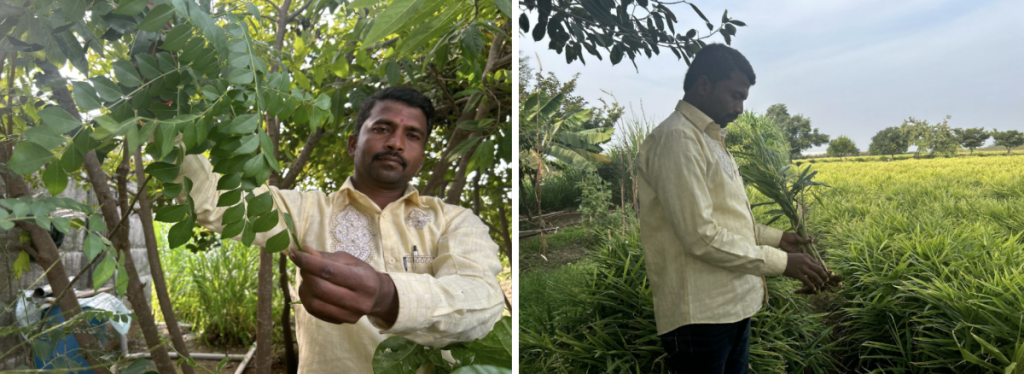
Farmer Kailash Tipli shows turmeric and curry leaves grown in his organic farm in Jalna. Photos: Amitha Balachandra.
Kailas Teple is not alone. Farmer Radheshyam Teple used fertiliser in two acres of his land and organic manure in the other two acres at the time of plantation during the COVID pandemic to see what difference it would make. He says his input cost went down by Rs. 10,000 over two years because he ended up using less fertiliser for the organic soil.
Scaling up this project and implementing these practices were challenges. “To do it on a large scale, it requires a lot of hard work. These days, the trend is to buy from the market. Many farmers benefited from this [project]. Some people said that their medical expenses have reduced,” says Kakasaheb Wadekar, senior assistant at Watershed Organisation Trust, who helped with this project for the non-profit on ground.
Is the government doing enough?
Certain government initiatives are trying to achieve similar climate-resilient agriculture practices among women farmers. The state government came up with the nutri-garden initiative to improve nutritional deficiencies in households. Dipti Patgaonkar, programme coordinator at the Krishi Vigyan Kendra (Farm Science Centre) in Chhatrapati Sambhaji Nagar, says that it has empowered women to grow their own vegetables, but scaling up is a challenge.
“So in our area, especially in the university, they recommended bio-fortified bajra, because it has more iron, more zinc, and we introduced it to the farmers. On a large scale, it will take time,” says Patgaonkar.
District health officials in both Beed and Chhatrapati Sambhaji Nagar refused to speak on record about the health outcomes in the region. The recently suspended civil surgeon of Beed’s district hospital, Dr. Ashok Thorat, asked us to delete his video and not to carry his quote, despite having spoken on record, due to fear of negative coverage.
Women like Jyoti, whose second son was healthy at birth, got better with the tablets she was prescribed. However, they have also become used to taking medication with each pregnancy.
In part three of the series, we break down the political nexus that drives this cropping pattern in the region.
Reporting for this story was supported by the Environmental Data Journalism Academy – a programme of Internews’ Earth Journalism Network and Thibi.
Data analysis for this series and the full methodology can be accessed here.
The Wire is now on WhatsApp. Follow our channel for sharp analysis and opinions on the latest developments.




